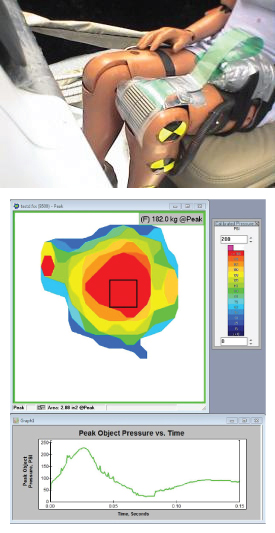Quantifying Crash Dummy Impact Pressures
 Figure 1: Output of peak pressure exerted upon a crash test dummy's knee during high-speed impact/collision testing.
Figure 1: Output of peak pressure exerted upon a crash test dummy's knee during high-speed impact/collision testing.
Challenge:
Crash dummies are effective tools for simulating what may happen to drivers and passengers in an automobile accident. What most crash dummies lack today, however, is a method to truly quantify these impacts, both from a measure of impact force, and by a measure of the total area on the dummy that experienced the instant impact.
Solution:
One automobile manufacturer used pressure mapping technology to identify the temporal, local, peak, and spatial pressures experienced by a crash dummy during vehicle impact. In the example shown in Figure 1, a pressure mapping sensor was attached to the crash dummy’s knee to capture impacts that could be felt from below the dashboard.
The flexibility of these pressure mapping sensors allowed the design engineers to reposition the sensor on just about any part of the crash dummy, including feet, arms, chest, and head. With scanning speeds up to 20 kHz, the hardware can record extremely rapid strikes, ten times as fast as competitive pressure impact systems.
Similar applications for this high-speed pressure impact system include seat belt design, airbag design, and racing helmet and padding design.